The prehistory of New Jersey might as well be called the “Tale of Two Jerseys.” The southern half of New Jersey was covered by a shallow sea, which was home to creatures like trilobites and brachiopods for much of the Paleozoic, Mesozoic, and Cenozoic eras. The state’s northern half provided habitat for all terrestrial creatures, including giant megafauna mammals like the American Mastodon, dinosaurs, and prehistoric crocodiles. Read on for more information on the most notable extinct animals in New Jersey.
8 Extinct Animals That Lived In New Jersey
The following 8 species have been lost forever, not just in New Jersey but across the entire planet. Their stories may help us understand how we can better protect the extant species so that we don’t lose them in the long run.
1. Hadrosaurus
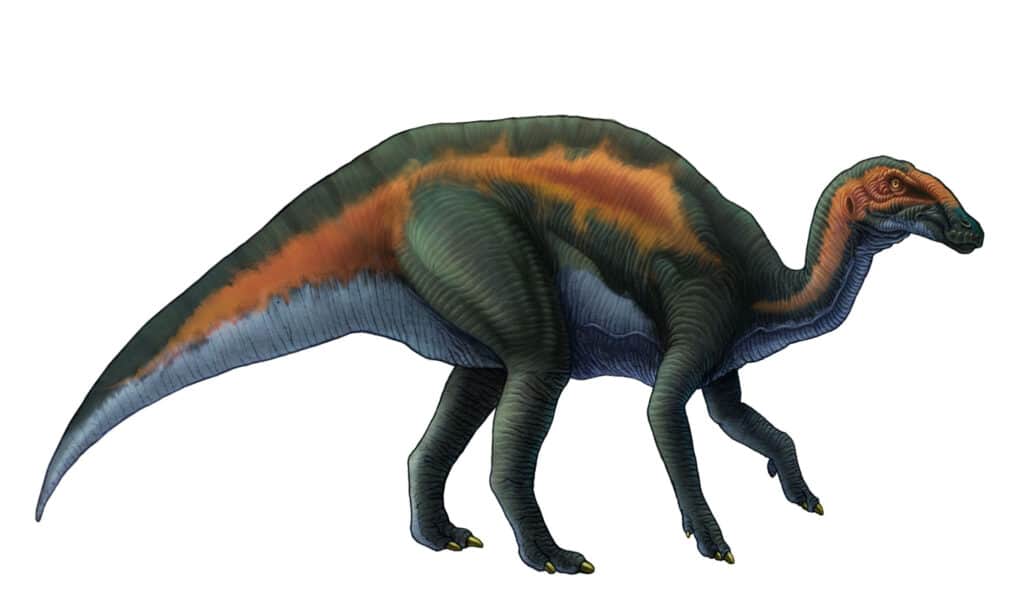
Hadrosaurus is a large bipedal dinosaur from the Late Cretaceous period.
©Bee_acg/Shutterstock.com
| Hadrosaurus | |
|---|---|
| Kingdom | Animalia |
| Phylum | Chordata |
| Clade | Dinosauria |
| Order | Ornithischia |
| Clade | Ornithopoda |
| Family | Hadrosauridae |
| Subfamily | Hadrosaurinae |
| Genus | Hadrosaurus |
| Living period | 80.5 and 78.5 million years ago |
Hadrosaurus is the official state fossil of New Jersey. It’s a large bipedal dinosaur from the Late Cretaceous period, about 80 million to 78 million years ago.
Hadrosaurus was an enormous creature that weighed up to 8,800 pounds and measured approximately 23–26 feet in total length and 8–10 feet in height. This creature possessed a relatively short crest on the top of its head. Its hindlimbs were more heavily built than the forelimbs.
The first and only nearly complete hadrosaur skeleton was discovered near the town of Haddonfield by the American paleontologist Joseph Leidy. This discovery marked a significant moment in the field of vertebrate paleontology in the late 1800s. Hadrosaurus became extinct along with the rest of the dinosaurs because of a massive meteorite impact roughly 66 million years ago.
2. Dryptosaurus
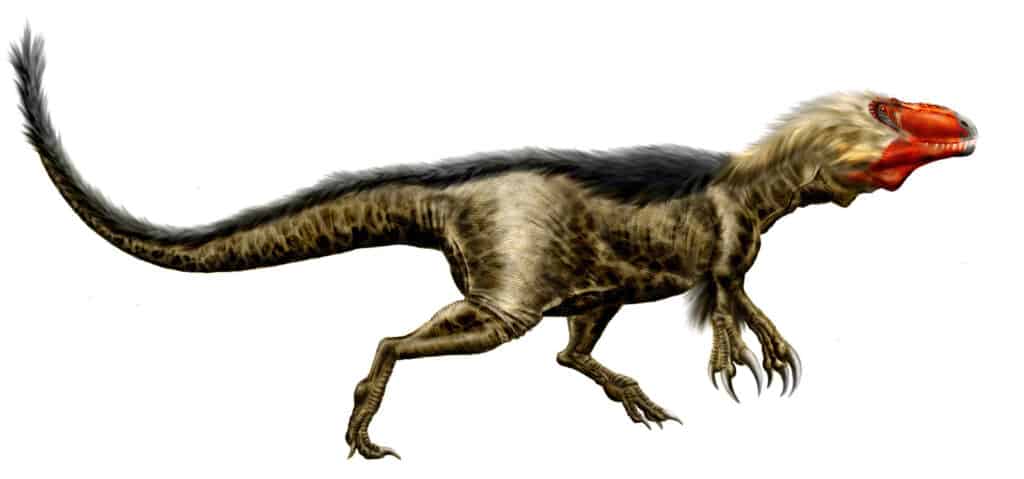
Dryptosaurus is best known as the “tearing lizard.”
©Josep Asensi: http://durbed.deviantart.com / CC BY 3.0 – License
| Dryptosaurus | |
|---|---|
| Kingdom | Animalia |
| Phylum | Chordata |
| Clade | Dinosauria |
| Clade | Saurischia |
| Clade | Theropoda |
| Clade | Eutyrannosauria |
| Family | Dryptosauridae |
| Genus | Dryptosaurus |
| Species | Dryptosaurus aquilunguis |
| Living period | Cretaceous period, approximately 67 million years ago |
Dryptosaurus is best known as the “tearing lizard,” and it is among the earliest theropod dinosaurs known to science. It was the first tyrannosaurus to be discovered in the United States. Edward Drinker Cope, the famous paleontologist, found dryptosaurus skeletons in New Jersey in 1866. This creature became extinct 66 million years ago.
It was estimated to have measured 25 feet long and weighed approximately 3,400 pounds. Based on the fossils, Dryptosaurus most likely had relatively long arms with talon-like claws. It may have used its hands and jaws as weapons when hunting and eating prey.
3. Diplurus
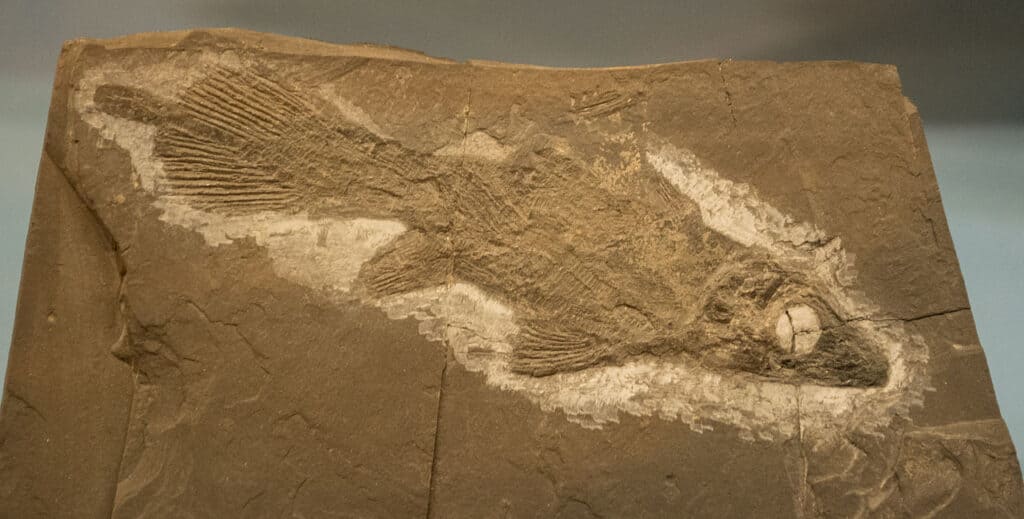
Diplurus is a genus of coelacanth fish that went extinct millions of years ago.
©Tim Evanson / CC BY-SA 2.0 – License
| Diplurus | |
|---|---|
| Kingdom | Animalia |
| Phylum | Chordata |
| Subphylum | Vertebrata |
| Class | Sarcopterygii |
| Order | Coelacanthiformes |
| Family | Mawsoniidae |
| Genus | Diplurus |
| Living Period | Early Jurassic Epoch, around 200 million years ago |
Diplurus is a genus of coelacanth fish that went extinct millions of years ago. It was a large, plump, lobe-finned fish that grew to 6.5 feet long and weighed approximately 200 pounds. It primarily fed on smaller fish species, including the bronze whiptail, the cardinal fish, the brotula barbata, and the splendid alfonsino. Based on the analysis of annual growth marks on scales, Diplurus was estimated to live up to 100 years and attain sexual maturity at 55.
4. The American Mastodon
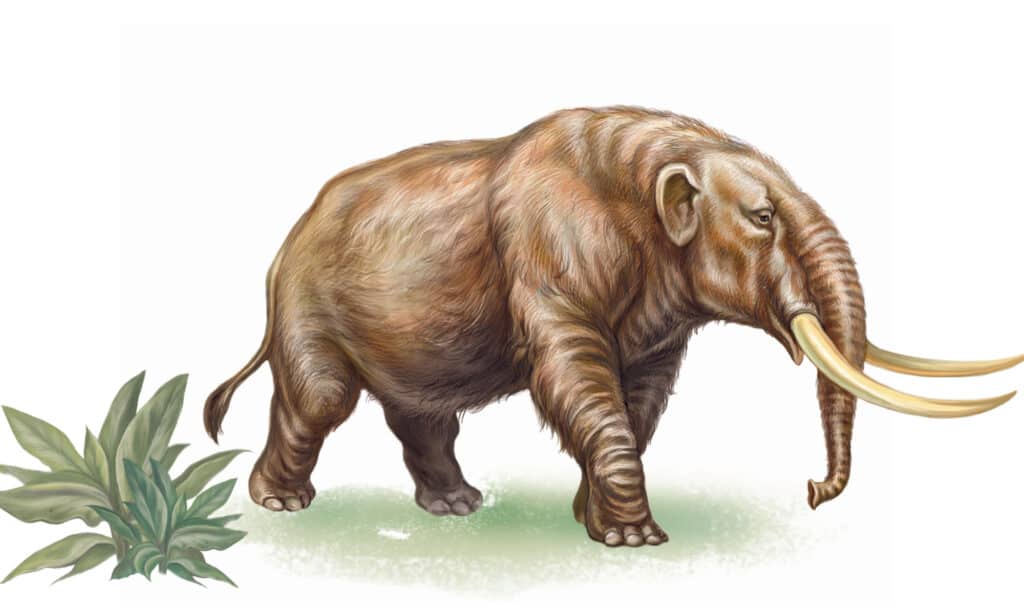
Mastodons were very social animals who preferred living in herds.
©Liliya Butenko/Shutterstock.com
| The American Mastodon | |
|---|---|
| Kingdom | Animalia |
| Phylum | Chordata |
| Class | Mammalia |
| Order | Proboscidea |
| Family | Mammutidae |
| Genus | Mammut |
| Living period | Late Miocene or late Pliocene – 11,000 years ago |
The American mastodon is an extinct species of proboscidean that lived in North and Central America up to its extinction approximately 11,000 years ago. Mastodons were very social animals who preferred living in herds. They obtained food by browsing and grazing. Based on modern skeletal reconstructions, mastodons closely resembled elephants and, to a lesser extent, mammoths. However, mastodons are not genetically closely related to either one.
The American mastodons were shorter and thicker in size as compared to mammoths. They measured approximately 7 feet tall, weighing 17,200 to 24,000 pounds (8.6 to 12 tons). Mastodons had shorter, straighter tusks, about 8 feet long.
American mastodon remains have been periodically discovered in various New Jersey townships and offshore on the continental shelf, starting in the mid-19th century in Greendell. The specimens date from the late Pleistocene epoch.
5. Deinosuchus
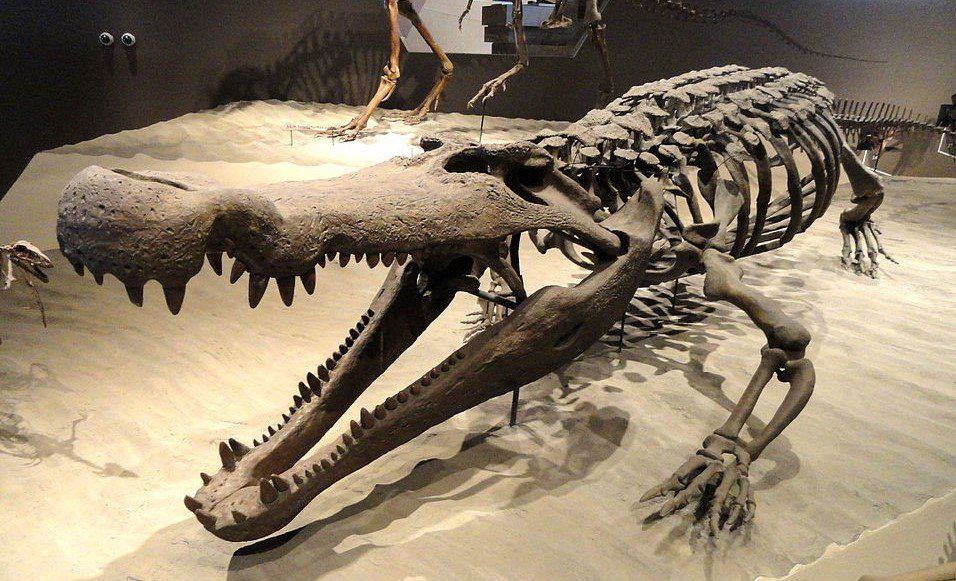
Deinosuchus is an extinct genus of alligatoroid crocodilian that lived during the Late Cretaceous period.
©Daderot / CC0 1.0 – License
| Deinosuchus | |
|---|---|
| Kingdom | Animalia |
| Phylum | Chordata |
| Class | Reptilia |
| Order | Crocodilia |
| Superfamily | Alligatoroidea |
| Genus | Deinosuchus |
| Living period | 82 to 73 million years ago |
Deinosuchus is closely related to the modern alligator and caiman. It is an extinct genus of alligatoroid crocodilian that lived during the late Cretaceous period, about 82 to 73 million years ago. The newly described species of Deinosuchus lived along the Atlantic coastal plain from New Jersey to Mississippi.
Measuring 35 feet in total length, Deinosuchus was more prominent than any modern crocodile or alligator. It had thick and robust teeth that appeared to have been adapted for crushing rather than piercing since some of them were short, rounded, and blunt.
6. Icarosaurus

Icarosaurus was a small, gliding reptile from the Late Triassic.
©Nobu Tamura (http://spinops.blogspot.com) / CC BY 3.0 – License
| Icarosaurus | |
|---|---|
| Kingdom | Animalia |
| Phylum | Chordata |
| Class | Reptilia |
| Family | Kuehneosauridae |
| Genus | Icarosaurus |
| Living Period | Late Triassic and early Jurrasic, about 230 to 190 million years ago |
Icarosaurus was a small, gliding reptile from the Late Triassic. It vaguely resembled a moth and was closely related to lizards and the tuatara. It measured about 4 inches long from the skull to the hip. It had some gliding membranes, wing-like structures with a concave lower surface and a convex upper surface to facilitate gliding.
A teenage enthusiast discovered the only Icarosaurus fossil in 1960 in a North Bergen quarry. The skeleton was preserved at the American Museum of Natural History in New York for 40 years until a private collector purchased it for $167,000 and immediately donated it back to the museum for further study.
7. Eskimo Curlew
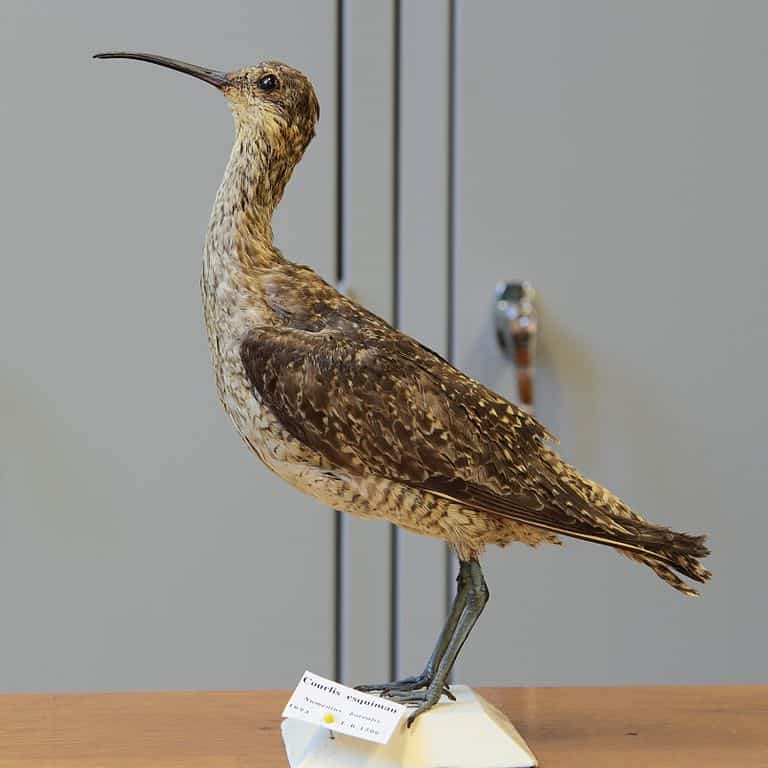
The Eskimo curlew fed primarily on small invertebrates like insects.
©Cephas / CC BY-SA 3.0 – License
| Eskimo Curlew | |
|---|---|
| Kingdom | Animalia |
| Phylum | Chordata |
| Class | Aves |
| Order | Charadriiformes |
| Family | Scolopacidae |
| Genus | Numenius |
| Species | Numenius borealis |
| Extinct Since | Presumed extinct in 1905, last sighting was in 1967 |
The Eskimo curlew (Numenius borealis), also known as the “northern curlew,” was one of many shorebirds that arrived in New Jersey during the fall migration from western Arctic Canada. It was about 12 inches in total length and had a long, decurved bill. It was mottled brown on top and pale on the belly. The Eskimo curlew feeds primarily on small invertebrates like insects. This incredible shorebird became extinct in the 1970s.
Before extinction, the Eskimo curlew was critically endangered from relentless hunting, insufficient prey, and the conversion of prairies into agriculture. They were an easy target for hunters who could kill multiple birds in a single shot since the Eskimo curlew migrated in large numbers.
8. Labrador Duck
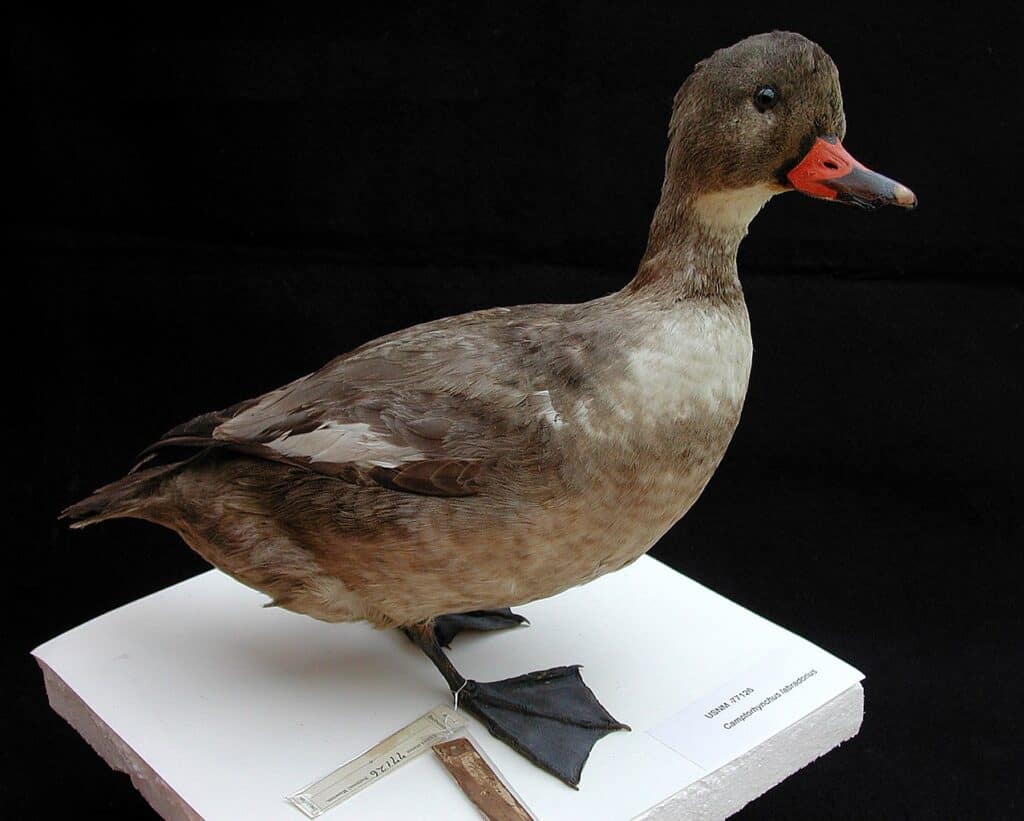
Labrador ducks became extinct around 1875.
©Smithsonian National Museum of Natural History – Vertebrate Zoology – Birds Division / CC0 1.0 – License
| Labrador Duck | |
|---|---|
| Kingdom | Animalia |
| Phylum | Chordata |
| Class | Aves |
| Order | Anseriformes |
| Family | Anatidae |
| Subfamily | Merginae |
| Genus | Camptorhynchus |
| Species | Camptorhynchus labradorius |
| Extinct since | 1878 |
The Labrador duck was a North American bird that wintered along the coast of New Jersey. It was about 20 inches in total length. The females were grey-brown, while the males had dark bodies with white marks on their wings, neck, and heads. They fed primarily on small mollusks. Labrador ducks became extinct around 1875.
The exact reason for their extinction remains unknown. Hunting was not the main reason for their extinction since their meat was said to taste foul. It’s presumed that their nesting sites were plundered or disturbed for eggs. It is also possible that changes in prey densities may have contributed to their extinction.
Summary Of The 8 Extinct Animals That Lived In New Jersey
| Rank | Extinct Animal | Living Period |
|---|---|---|
| 1 | Hadrosaurus | 80.5 and 78.5 million years ago |
| 2 | Dryptosaurus | approximately 67 million years ago |
| 3 | Diplurus | around 200 million years ago |
| 4 | American Mastodon | around 11,000 years ago |
| 5 | Deinosuchus | 82 to 73 million years ago |
| 6 | Icarosaurus | about 230 to 190 million years ago |
| 7 | Eskimo Curlew | Presumed extinct in 1905, last sighting was in 1967 |
| 8 | Labrador Duck | Extinct since 1878 |
The photo featured at the top of this post is © Liliya Butenko/Shutterstock.com
Thank you for reading! Have some feedback for us? Contact the AZ Animals editorial team.






